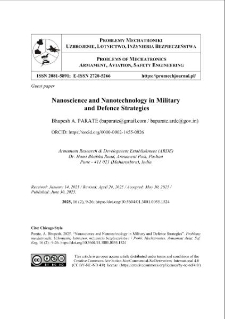Nasza Biblioteka Cyfrowa udostępnia 1 868 obiektów cyfrowych
Obiekt
Tytuł: Nanoscience and Nanotechnology in Militaryand Defence Strategies ; Nanoscience and Nanotechnology in Militaryand Defence Strategies
Abstrakt:
Nowadays, nanotechnology has become very popular, and life without it is difficult to imagine. This technology concerns nanomaterials and has wide applications in science, engineering, medicine, defence, and industrial sectors. Nanotechnology is a term coined by Norio Taniguchi in 1974. Usually, it is used to describe processes in semiconductors, such as thin-film deposition. It deals with phenomena on the scale of nanometres. The processes central to nanotechnology, such as separation, deformation, and consolidation, can be performed on a single atom or molecule. Compared to bulk materials, matter at the nanoscale exhibits unusual properties and is highly reactive. This affects the electrical properties and strength of these materials. The primary purpose of using this technology in various applications is to fabricate novel products, formulated with new materials and chemicals, and replace currently available equipment with systems offering improved performance levels. Carbon nanotubes play a role in enhancing the strength of materials, body armour, radar-absorbing structures, smart textiles, detection/neutralisation of warfare agents, wearable thermoelectric devices, water purification, sensors, and flat-panel displays. One significant strategy for sustainable development is the invention of lighter materials. These lighter materials are at the top of the list of innovative engineering materials that may be used in any technological or engineering sector. The content of this research paper is entirely based on an oration delivered by an author on ‘Technology Day’ that is celebrated every year. The author collected information through various research papers and internet those are available in the open access.
;
Nowadays, nanotechnology has become very popular, and life without it is difficult to imagine. This technology concerns nanomaterials and has wide applications in science, engineering, medicine, defence, and industrial sectors. Nanotechnology is a term coined by Norio Taniguchi in 1974. Usually, it is used to describe processes in semiconductors, such as thin-film deposition. It deals with phenomena on the scale of nanometres. The processes central to nanotechnology, such as separation, deformation, and consolidation, can be performed on a single atom or molecule. Compared to bulk materials, matter at the nanoscale exhibits unusual properties and is highly reactive. This affects the electrical properties and strength of these materials. The primary purpose of using this technology in various applications is to fabricate novel products, formulated with new materials and chemicals, and replace currently available equipment with systems offering improved performance levels. Carbon nanotubes play a role in enhancing the strength of materials, body armour, radar-absorbing structures, smart textiles, detection/neutralisation of warfare agents, wearable thermoelectric devices, water purification, sensors, and flat-panel displays. One significant strategy for sustainable development is the invention of lighter materials. These lighter materials are at the top of the list of innovative engineering materials that may be used in any technological or engineering sector. The content of this research paper is entirely based on an oration delivered by an author on ‘Technology Day’ that is celebrated every year. The author collected information through various research papers and internet those are available in the open access.
Miejsce wydania:
Warszawa
;
Warszawa
Wydawca:
Wojskowa Akademia Techniczna ; Wojskowa Akademia Techniczna
Data utworzenia:
Data złożenia:
Data akceptacji:
Data wydania:
Rozmiar:
Identyfikator:
oai:ribes-88.man.poznan.pl:2734
Sygnatura:
doi:10.5604/01.3001.0055.1524 ; doi:10.5604/01.3001.0055.1524
ISSN elektroniczny:
ISSN drukowany:
Język:
Licencja:
kliknij tutaj, żeby przejść ; kliknij tutaj, żeby przejść
Właściciel praw:
Wojskowa Akademia Techniczna ; Wojskowa Akademia Techniczna
Strona początkowa:
Strona końcowa:
Tom:
Czasopismo:
Słowa kluczowe:
carbon nano tube, graphene, nano, nanoscience, nanoscale, nanotechnology ; carbon nano tube, graphene, nano, nanoscience, nanoscale, nanotechnology
Kolekcje, do których przypisany jest obiekt:
Data ostatniej modyfikacji:
17 paź 2025
Data dodania obiektu:
17 paź 2025
Liczba wyświetleń treści obiektu:
0
Wszystkie dostępne wersje tego obiektu:
https://ribes-88.man.poznan.pl/publication/3075
Wyświetl opis w formacie RDF:
Wyświetl opis w formacie OAI-PMH:
| Nazwa wydania | Data |
|---|---|
| Nanoscience and Nanotechnology in Militaryand Defence Strategies | 17 paź 2025 |
Obiekty Podobne
Bhupesh Ambadas PARATE Sunil CHANDEL, Himanshu SHEKHAR, Viwek MAHTO
Bhupesh Ambadas PARATE Sunil CHANDEL, Himanshu SHEKHAR
Bhupesh Ambadas PARATE Sunil CHANDEL, Himanshu SHEKHAR

